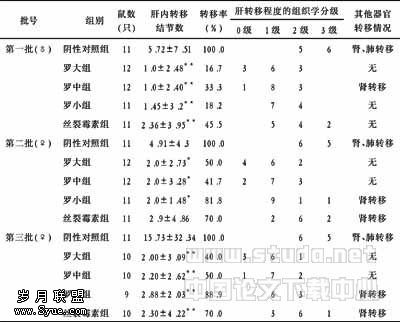青年乳腺癌临床特征与预后的分析
作者:诸林海 丁向民 王道荣
【摘要】 目的:探讨青年乳腺癌的临床病理特点及影响预后的因素。方法:回顾性分析61例青年组(≤35岁)和74例对照组(36~69岁) Ⅰ~Ⅲ期乳腺癌患者的临床资料。结果: 青年组pTNM分期、分化程度与对照组有显著差异。两组Ⅰ~Ⅱ期患者生存率无差异,Ⅲ期则有显著差异。结论:强调青年乳腺癌侵袭性强的同时,也要强调早期诊断和,可以取得与对照组生存率相同效果。
【关键词】 乳腺肿瘤 年龄 预后
Analysis of clinical features and prognostic factors in young women with stage Ⅰto Ⅲ breast cancers
【ABSTRACT】 Objective: To explore the clinical features and prognosis of breast cancers with different stages in young women. Methods: A retrospective study was made in 61 cases of young patients with breast cancer (≤35 years as young group) and 74 cases of breast cancer patients of control group (36-69 years), who were with stageⅠto Ⅲ disease underwent surgical treatment. Results: The significant differences were observed in pTNM staging and differentiation between two groups. There were no differences between the two groups in stage Ⅰand Ⅱ patients. Significant differences were found between the two groups in stage Ⅲ patients. Conclusion: Breast cancer was with strong invasion in young patients. Early diagnosis and treatment of young women with breast cancer were important to improve the survival rate.
【KEY WORDS】 Breast cancer·Age factor·Prognosis 我国乳腺癌高发年龄是40~50岁,临床上青年乳腺癌(≤35岁)较为少见,近年有增加趋势。青年乳腺癌生物学行为不同于年长妇女,预后仍存在争议[1-4]。本研究以61例青年乳腺癌和74例对照组乳腺癌患者为研究对象,分析其临床诊断、病理特征、治疗方法以及pTNM分期对预后的影响,探讨内在联系,指导临床实践。
1 资料与方法
1.1 一般资料 回顾性分析我院1999年1月~2004年12月青年女性乳腺癌(青年组)Ⅰ~Ⅲ期61例相关资料,所有病例均经临床病理确诊。年龄24~35岁,平均年龄 (31.10±2.53)岁。其中单发肿瘤55例(90.2%),多发肿瘤6例(9.8%),一级亲属患有乳腺癌或卵巢癌家族史7例(11.5%)。随机抽取同期住院的年龄36~69岁(注:70岁以上患者死亡率增加,会对生存率产生偏差)行手术治疗,经临床病理确诊乳腺癌患者中74例作为对照(对照组),平均年龄(49.68±9.34)岁。参照Bloonr Richardson(1957年)和Elston等(1991)分级标准,分期采用pTNM国际分期法。
1.2 雌、孕激素受体测定方法及阳性结果判断 采用SABC法检测雌激素受体(estrogen receptor, ER)和孕激素受体(progesterone receptor, PR),以细胞胞质或胞核内含棕黄色颗粒为阳性细胞,阳性细胞总数>10%为阳性病例。
1.3 统计学分析 采用Prism3.0统计软件包进行数据处理,组间率的比较采用χ2检验;生存资料用Logrank时序检验和Kaplan-Meier生存曲线表示,检验水平α=0.05。
2 结果
2.1 两组临床和病理指标构成比的比较 青年组发现肿瘤方法、临床分期、分化程度与对照组比较差异有统计学意义,P<0.05;两组在组织类型、ER和PR的阳性率、手术方式及综合治疗方式的构成比差异均无统计学意义,P>0.05(表1)。
2.2 两组生存率比较 患者的随访率为93.3 % ,Ⅰ~Ⅱ期青年组失访3 例,随访期12~60个月,平均随访53个月;对照组失访3例,随访期10~60个月,平均随访56个月;5年总生存率分别为81.9%和88.8%,两组生存率曲线无明显差别,P=0.364 7(图1)。Ⅲ期青年组失访3 例,随访期9~60个月,平均随访41.5个月;对照组无失访,随访期21~60个月,平均随访55.5个月;5年总生存率分别为53.7%和84.2%,两组生存率曲线差异有统计学意义,P=0.043 4(图2)。
3 讨论
青年乳腺癌(≤35岁)约占乳腺癌总数的15%~25%[5],Guidelines等[6]指出青年乳腺癌肿瘤分期晚,核分裂像多,血管淋巴结侵袭比率高等临床病例特点。可能与以下原因有关: 1)雌激素水平。青年乳腺癌女性患者卵巢功能旺盛,血液中内源性雌激素含量高,可能是肿瘤恶性程度高、转移早、预后差的影响因素。2)细胞分期。肿瘤细胞多处于S期[7],侵袭性强、易转移、快、预后差。3)家族史。含有胚系BRCA1、BRCA2、TP53、PTEN突变者,一级亲属患卵巢癌或乳腺癌者属高危人群,往往较早发生乳腺癌[8]。本研究有乳腺癌家族史的青年患者7例(11.5%)。有研究表明,局限性青年乳腺癌5年和10年生存率分别为89%和78%,而出现淋巴转移的患者5年和10年存活率分别为56%和31% ,出现远处转移患者10年生存率仅为11%[9],说明早期诊治可以显著改善青年乳腺癌的预后。本研究结果显示,Ⅰ、Ⅱ期青年组与对照组相比5年生存率无明显差异(P=0.364 7),而Ⅲ期两组生存率差异有统计学意义,P=0.043 4,与上述相符。
青年乳腺癌由于其生理特点,早期诊断有一定困难,常见的延误原因包括: 1)青年女性自身不够重视,保健意识薄弱,自检困难以及恐惧、害羞的心理常导致就诊延迟。本研究中有症状而就诊23例,约占37.7%。2)青年女性的乳房丰硕、密实、富有结节感,受月经周期的影响大,也是干扰正确诊断的因素[10]。3) 当前医疗辅助诊断技术对青年乳腺癌缺乏特异性[11]。如青年女性中较少使用乳房摄影术,钼靶摄影因青年女性乳腺密度高,成片后读片困难[12],本研究中经摄片而确诊者仅占6.5%。超声诊断虽然可发现密度异常的肿块,但在区别良恶性肿瘤时不尽人意。MRI价格贵,不可能多次体检,敏感性虽高但特异性低[13],多发纤维腺瘤和良性乳腺增生症易与癌瘤混淆。4) 多数青年女性的乳腺肿块为良性,恶性肿瘤占少数[11],容易漏诊。5) 缺乏严格的随访制度。
为此,要提高青年女性自我保健意识,普及自我体检的技巧,发现肿块后立即就诊;建议高危人群定期体检,每月1次临床体检,半年或1年1次摄影、B超或MRI检查[8];不随月经周期改变的乳腺肿块早做细胞学诊断,如可疑则行冷冻切片检查。有报道结合临床体检、乳腺摄影,细针抽吸可以提供92%的诊断正确率[14]。青年乳腺癌只要早期发现,早期,Ⅰ~Ⅱ期的生存率与对照组无差别。
【文献】
[1] Althuis MD, Brogan DD, Coates RJ, et al. Breast cancers among very young pre menopausal women(United States)[J]. Cancer Causes Control, 2003,14(2):151-160.
[2] Maggard MA, O’Connell JB, Lane KE, et al. Do young breast cancer patients have worse outcomes[J]. J surg Res, 2003,113(1):109-113.
[3] Gajdos C, Tartter PI, Bleiweiss IJ, et al. Stage 0 to stage Ⅲ breast cancer in young women[J]. J Am Coll Surg, 2000,190(5):523-529.
[4] Chia KS, Du WB, Sankaranarayanan R, et al. Do younger female breast cancer patients have a poorer prognosis? Results from a population-based survival analysis[J].Int J Cancer, 2004,108(5):761-765.
[5] Elisabetta R, Gerald F, Helena M, et al. Survival of young and older breast cancer patients in Geneva From 1990 to 2001[J]. Eur J cancer,2005,41(2):1446-1452.
[6] Goldhirsch A, Wood WC, Gelber RD, et al. Meeting highlights:updated international expert consensus on the primary thery of early breast cancer[J]. J Clin Oncol, 2003, 21 (17) : 3357- 3365.
[7] 李树铃.乳腺肿瘤学[M].北京:技术文献出版社,2003:628.
[8] George H, Sakorafas MD.Women at High risk for breast cancer:preventive strategies[J].The mount Sinai jounal of Medicine,2002:69(4):264-266.
[9] Sariego J, Zada S, Byrd M. Breast cancer in young patients[J]. Am J Surg, 1995,170 (3): 243-245.
[10] Shannon C, Smith IE. Breast cancer in adolescents and young women[J]. Eur J Can, 2003,39(18): 2632-2642.
[11] Lannin DR, Harris RP, Swanson FH, et al. Difficulties in disgnosis of carcinoma of the breast in patients less than fifty years of age[J].Surg Gynecol Obstet,1993,177(5):457-462.
[12] Patricia A, Carney, Diana L, et al. Individual and Combined Effects of Age, breast Density, and Hormone Replacement Therapy Use on the Accuracy of Screening mammography[J]. Ann Intern Med, 2003,138 (3) :168-175.
[13] Kriege M, Brekelmans CT, Boetes C, et al. Efficacy of MRI and mammography for breast-cancer screening in women with a familial or genetic predisposition[J]. N Engl J Med, 2004,351(5):427-437.
[14] Hamill J, Campbell ID, Mayall F, et al. Improved breast cytology results with near patient FNA diagnosis[J]. Acta Cytol, 2002,46(1): 19-24.











